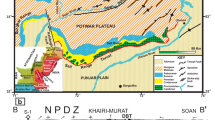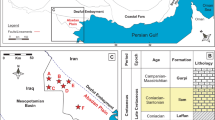Abstract
The present integrated study aims to study the sedimentary microfacies and reservoir characterization of the middle Jurassic carbonates (Chiltan Formation) succession exposed in lower Indus Basin, Pakistan. The plug porosity/permeability analysis and petrographic studies were carried out for the identification of facies and reservoir potential of the rock unit. The petrographic details show three microfacies in the rock unit including ooidal/peloidal grainstone microfacies, bioclastic grainstone microfacies and mudstone microfacies. The grainstone microfacies indicate deposition of carbonates in the high energy shallow inner shelf environment, while the mudstone microfacies indicate deposition in the restricted shelf environment. The visual porosity estimation shows the existence of secondary porosity in the form of minute fractures up to 7% and dissolution (vuggy) porosity up to 8%, while very low permeability is the characteristic of rock unit. This estimation is further supported by the plug porosity/permeability estimation that ranges from 0 to 11.5% porosity and 0–2.75 Ka Md permeability. The SEM also holds up the same interpretation and shows minute pore spaces between the grains. By integrating all the studies, it is concluded that the middle Jurassic carbonates of lower Indus Basin (Chiltan Formation) are poor-quality reservoir rock unit.
Copyright 2018, Shaanxi Petroleum Society.
This paper was prepared for presentation at the 2018 International Field Exploration and Development Conference in Xi’an, China, 18–20 September 2018.
This paper was selected for presentation by the IFEDC&IPPTC Committee following review of information contained in an abstract submitted by the author(s). Contents of the paper, as presented, have not been reviewed by the IFEDC&IPPTC Committee and are subject to correction by the author(s). The material does not necessarily reflect any position of the IFEDC&IPPTC Committee, its members. Papers presented at the Conference are subject to publication review by Professional Committee of Petroleum Engineering of Shaanxi Petroleum Society. Electronic reproduction, distribution, or storage of any part of this paper for commercial purposes without the written consent of Shaanxi Petroleum Society is prohibited. Permission to reproduce in print is restricted to an abstract of not more than 300 words; illustrations may not be copied. The abstract must contain conspicuous acknowledgment of IFEDC&IPPTC. Contact email: paper@ifedc.org.
Access provided by Autonomous University of Puebla. Download conference paper PDF
Similar content being viewed by others
Keywords
1 Introduction
The Indus Basin of Pakistan is the most studied and productive basin in the context of petroleum potential. The Indus Basin can be divided into upper and lower Indus Basin [1]. The stratigraphy of lower Indus Basin ranges from late Triassic to Pleistocene [2]. The marine carbonate succession of middle Jurassic Chiltan Formation is well exposed in the Mughal Kot section of lower Indus Basin (Fig. 1). This unit was first recognized by Williams [3]. The rock unit is composed of wide varieties of limestone units [2]. It is comprised of coarse-grained, pelletal, bioclastic, lumpy, oolitic limestone having dark to light gray and brown color [2]. Similarly, there is much variation in the thickness of the rock unit. Such variation in lithology, deposition and structure indicates the deposition of the strata under the most diverse conditions [2]. The Cretaceous rocks lie directly above the middle Jurassic carbonates in the studied basin and mark an unconformity in lower Indus Basin [4]. This unconformity is due to the rifting of Gondwana in Jurassic time [4].
Various researchers have evaluated the rock unit in different aspects. Shah has studied the lithological and sedimentological variation in the strata [2]. Williams identified the unit for the first time [3]. The formation is correlated with other parts of the basin by Anwar et al. [5]. However, no integrated approach is utilized to accurately study the rock unit in different context. Therefore, the present integrated study aims to investigate the middle Jurassic carbonates in the context of facies analysis, depositional modeling and reservoir characterization.
2 Methodology
The Chiltan Formation exposed in lower Indus Basin is measured and sampled at regular interval. The stratigraphic logging was carried out using conventional methods. All field features of the limestone were observed and noted at the outcrop scale. The representative carbonate samples were collected in systematic manner. The carbonates were classified using Dunham [6] classification, and the microfacies were established using Flügel scheme [7]. The representative photomicrographs were taken with the help of Olympus DP12 microscope with a digital camera installed at the Sedimentology Laboratory in the Department of Geology, University of Peshawar. The plug porosity and permeability of selected rock samples were determined by using PoreMaster Series Porosimeter at the Hydrocarbon Development Institute of Pakistan. The Corel Draw X7 software was used for the artwork.
3 Results and Discussions
3.1 Petrographic Analysis
The details of main petrographic features including type and percentage of grains, amount of matrix, cement and visually estimated porosity are calculated. Subsequently, the petrographic data are used to describe the microfacies which in turn used for the interpretation of the depositional environments of the formation.
3.2 Microfacies Analysis
Based on the detailed thin sections study, the following facies have been recognized in the Chiltan Formation:
-
(i)
Ooidal/peloidal grainstone microfacies;
-
(ii)
Bioclastic grainstone microfacies;
-
(iii)
Mudstone microfacies.
3.2.1 Ooidal/Peloidal Grainstone Microfacies
These microfacies consist of abundant ooidals/peloids (60%). It also comprised of other constituents that include intraclasts (05%), pisoid (05%), oncoid (06%). These are embedded by coarse sparry calcite cement (22%). Lumps and grapestone fabric are also observed. The allochems are moderately sorted (see Fig. 2).
3.2.2 Bioclastic Grainstone Microfacies
The bioclasts are the major constituent of these microfacies that range up to 63%, while cement is 32% and remaining allochems are 05%. The bioclasts are represented mostly by foraminifera, echinoderms, gastropods and brachiopods (see Fig. 3).
3.2.3 Mudstone Microfacies
The mudstone is predominantly composed of lime mud as matrix that ranges up to 88% and trace amount of allochems up to 03% in the form of bioclasts including echinoid spines and bivalve. Remaining 09% is mostly microspars that develop in diagenetic stage (see Fig. 4).
3.3 Depositional Model
The Chiltan Limestone is deposited in inner shelf environment with high energy, wave and tide-dominated shoals to low energy, below storm wave base slope environment [7]. Wave-disturbed, shallow water, high energy conditions are interpreted by the presence of ooids and pisoids. Sand shoal/barrier ooidal grainstone facies were deposited in a platform margin sub-environment that separated open marine from restricted-marine environments [7]. The dominance of micrite and dearth of biotic components indicate a considerable depth of water, below storm wave base [7] (see Fig. 5).
3.4 Reservoir Characterization
The petroleum reservoir characterization of the Chiltan Limestone is based on the integration of different microfacies and plug porosity and permeability data. Visual porosity in thin section mostly indicates that the presence of secondary porosity exists in the form of fractures. Such fracture porosity ranges up to 05%, and vuggy porosity ranges up to 10%. On the other hand, the visual permeability is interpreted as low. Similarly, the plug poroperm minimum value is 0.00%, 0.00 Ka Md, and maximum value is 11.5%, 2.5 Ka Md (Table 1). On the basis of these properties, the reservoir potential of Chiltan Limestone is categorized as “poor” quality reservoir rock unit.
4 Conclusions
The detail laboratory work and field investigations revealed the following conclusions:
-
Three microfacies are identified in the Chiltan Formation including ooidal/peloidal grainstone microfacies, bioclastic grainstone microfacies and mudstone microfacies.
-
The grainstone microfacies indicate deposition of carbonates in the high energy shallow inner shelf environment, while the mudstone microfacies indicate deposition in the restricted shelf environment.
-
The petrographic studies and plug porosity/permeability data indicated that the rock unit is poor-quality reservoir.
References
Malkani MS. Updated stratigraphy and mineral potential of Sulaiman basin Pakistan. Sindh Univ Res J. (Sci Ser). 2010;42(2):39–66.
Shah S. Stratigraphy of Pakistan. Mem Geol Surv Pak. 2009; 22.
Williams MD. Stratigraphy of the Lower Indus Basin, West Pakistan. In: 5th World Petroleum Congress; 1959.
Kadri IB. Petroleum geology of Pakistan. Pakistan Petroleum Limited; 1995.
Anwar M, Fatmi A, Hyderi I. Revised nomenclature and stratigraphy of Ferozabad, Alozai and Mona Jhal geoups of Balochistan. Acta Mineral, Pak. 1991; 41–66.
Dunham RJ. Classification of carbonate rocks according to depositional texture. In: Ham WE (ed.), Classification of carbonate rocks. Memoirs of the American Association of Petroleum Geologists; 1962. p. 108–21.
Flügel E. Microfacies of carbonate rocks-analysis, interpretation and application. Berlin: Springer; 2004. p. 1–976.
Acknowledgements
Authors are thankful to Department of Geology, University of Peshawar, Pakistan, for providing laboratory facilities.
Author information
Authors and Affiliations
Corresponding author
Editor information
Editors and Affiliations
Rights and permissions
Copyright information
© 2020 Springer Nature Singapore Pte Ltd.
About this paper
Cite this paper
Wadood, B., Ahmad, S., Khan, S. (2020). Sedimentary Microfacies Analysis and Reservoir Characterization of the Middle Jurassic Carbonates: A Case Study from Lower Indus Basin, Pakistan. In: Lin, J. (eds) Proceedings of the International Field Exploration and Development Conference 2018. IFEDC 2018. Springer Series in Geomechanics and Geoengineering. Springer, Singapore. https://doi.org/10.1007/978-981-13-7127-1_187
Download citation
DOI: https://doi.org/10.1007/978-981-13-7127-1_187
Published:
Publisher Name: Springer, Singapore
Print ISBN: 978-981-13-7126-4
Online ISBN: 978-981-13-7127-1
eBook Packages: EngineeringEngineering (R0)









